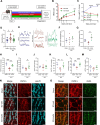Diet-microbiome interactions promote enteric nervous system resilience following spinal cord injury
- PMID: 39209925
- PMCID: PMC11362535
- DOI: 10.1038/s41522-024-00556-y
Diet-microbiome interactions promote enteric nervous system resilience following spinal cord injury
Abstract
Spinal cord injury (SCI) results in numerous systemic dysfunctions, including intestinal dysmotility and enteric nervous system (ENS) atrophy. The ENS has capacity to recover following perturbation, yet intestinal pathologies persist. With emerging evidence demonstrating SCI-induced alterations to gut microbiome composition, we hypothesized that microbiome modulation contributes to post-injury enteric recovery. Here, we show that intervention with the dietary fiber, inulin, prevents SCI-induced ENS atrophy and dysmotility in mice. While SCI-associated microbiomes and specific injury-sensitive gut microbes are not sufficient to modulate intestinal dysmotility after injury, intervention with microbially-derived short-chain fatty acid (SCFA) metabolites prevents ENS dysfunctions in injured mice. Notably, inulin-mediated resilience is dependent on IL-10 signaling, highlighting a critical diet-microbiome-immune axis that promotes ENS resilience post-injury. Overall, we demonstrate that diet and microbially-derived signals distinctly impact ENS survival after traumatic spinal injury and represent a foundation to uncover etiological mechanisms and future therapeutics for SCI-induced neurogenic bowel.
© 2024. The Author(s).
Conflict of interest statement
The authors declare no competing interests.
Figures





Update of
-
Diet-microbiome interactions promote enteric nervous system resilience following spinal cord injury.bioRxiv [Preprint]. 2024 Jun 8:2024.06.06.597793. doi: 10.1101/2024.06.06.597793. bioRxiv. 2024. Update in: NPJ Biofilms Microbiomes. 2024 Aug 29;10(1):75. doi: 10.1038/s41522-024-00556-y. PMID: 38895207 Free PMC article. Updated. Preprint.
References
MeSH terms
Substances
Grants and funding
- NS096050-24/U.S. Department of Health & Human Services | NIH | National Institute of Neurological Disorders and Stroke (NINDS)
- F31AG076332/U.S. Department of Health & Human Services | NIH | National Institute on Aging (U.S. National Institute on Aging)
- R01DK080684/U.S. Department of Health & Human Services | NIH | National Institute of Diabetes and Digestive and Kidney Diseases (National Institute of Diabetes & Digestive & Kidney Diseases)
- R01 DK080684/DK/NIDDK NIH HHS/United States
- F31 AG076332/AG/NIA NIH HHS/United States
- UL1 TR002378/TR/NCATS NIH HHS/United States
- T32 NS096050/NS/NINDS NIH HHS/United States
- R01ES032440/U.S. Department of Health & Human Services | NIH | National Institute of Environmental Health Sciences (NIEHS)
- 642928/Craig H. Neilsen Foundation (Neilsen Foundation)
- I01 BX000136/BX/BLRD VA/United States
- R01 ES032440/ES/NIEHS NIH HHS/United States
LinkOut - more resources
Full Text Sources
Medical

